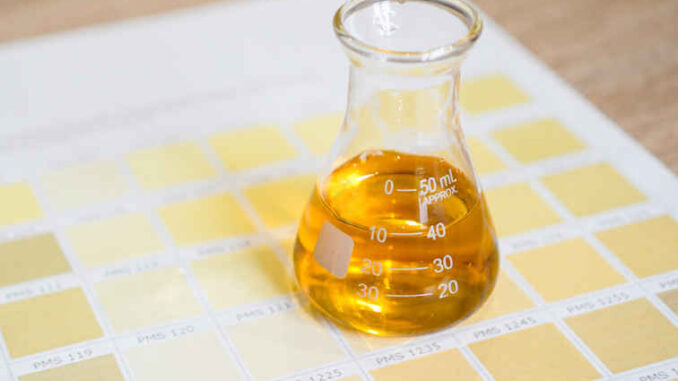
This article was updated on December 20th, 2022
Are you curious about what your dog’s urine color means? Some dogs go potty indoors on a pad, so their owners will notice slight changes to the color because they see it every day. Then there are dogs who spend most of their time romping around outdoors and their owners only notice a problem when they find a pink, soaked spot on the living room carpet. Whichever scenario matches you and your dog, here is what you need to know about dogs, their urine colors, and whether you can just clean up the mess or if you should also call up your vet.
In this article, we will review two dog urine color charts to help you understand what different urine colors mean, and what to do for each color.
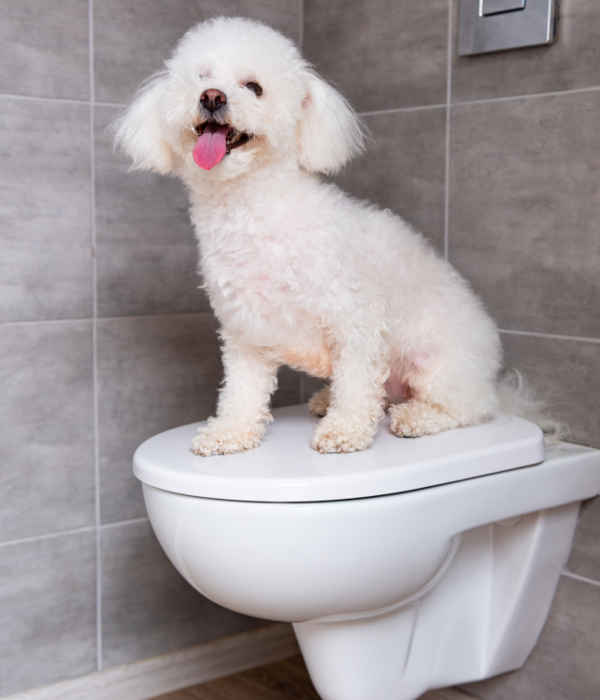
What is urine and why is it important?
Urine is not typically a pleasant thing to think about, but it performs the very important task of excreting unneeded water, sodium, and waste products such as urea that the kidneys have filtered out of the blood.
Urine is actually a very important biologic fluid that can be analyzed for the purpose of preventing problems in a healthy dog or evaluating the condition of a dog who is unwell. It is also good indicator of problems because you can learn what the normal appearance of urine is and what to do when it appears abnormal.
A dog’s urine is formed through the work of the kidneys, and then the urine is transported and stored in the bladder until urination occurs. Along the way, changes to its normal appearance can occur due to many reasons:
- Normal variation
- Problems in the urinary system itself (the kidneys, the ureters that transport urine to the bladder, the bladder, or the urethra, where the urine exits the body)
- Problems in the genital regions (prostate for male dogs, vagina and vulva in females)
- A sign of a problem affecting other areas of the body, such as poisoning, muscle damage, or liver disease, to name a few
This article will be focusing on urine color and general appearance, since these are practical for dog owners to consider at home. There are many other factors that come into play when evaluating urine that may be mentioned but not discussed in detail, such as urine specific gravity, urine pH, etc.
What should a normal dog’s urine color be?
The normal appearance of a dog’s urine should be clear and pale yellow, yellow, or amber, as in the three vials on the left in this example.
The color and cloudiness of a dog’s urine can indicate changes internally. It is important to know when the change in color and cloudiness are cause for concern.
Turbidity (Haziness or cloudiness)
Urine can appear cloudy due to materials such as cells, crystals, bacteria, fats, and mucus. Mucus and fats can cause cloudiness in normal urine. However, the presence of crystals, bacteria, or increase in cells can indicate an abnormality. A microscopic examination of urine is needed to differentiate between these causes.
Color
The color of urine can be an indicator of changes to the body or even a serious problem going on internally. The color is a result of concentration of urine (how much water is being eliminated) and the specific compounds or materials that are present.
Common causes of urine color changes
Two very common reasons for changes in urine color include dehydration and urinary tract infection (UTI).
Dehydration
Dehydration means that there isn’t enough water in the body for normal body functions, whether that’s due to not enough water intake, or water loss through processes like vomiting or diarrhea. When dehydration occurs, the kidneys try to retain more water in the body and that causes a decrease in the fluid portion of urine. This ultimately causes the urine to appear a darker yellow color and to have an increased urine concentration.
Fortunately, dehydration is a condition that can be corrected. At home, very mild dehydration can be addressed by encouraging your dog to drink more water. Sometimes changing the type of bowl, location, or even using a running water fountain may help. For dogs who refuse to drink water, soaking their food in water may be the only way to up their intake. For more severe cases of dehydration, a visit to the vet may be warranted. Treatments such as injections of fluids under the skin or into the veins may be helpful depending on the case.
Urinary Tract Infection
For dogs with urinary tract infections, the urine color can vary from dark and cloudy yellow to pink or red tinged. The dark, cloudy appearance is usually due to a combination of white blood cells and bacterial organisms. The pink to red color occurs if there is a significant amount of red blood cells in the urine caused by the inflammation secondary to the infection. Aside from a change in color, urinary tract infections are typically uncomfortable and can be accompanied by symptoms such as pain during urination, straining to urinate, and frequent, small volume urinations.
Urinary tract infections require a diagnosis from a veterinarian using tests such as urine analysis and urine culture. Treatment is typically straightforward using antibiotic medications. Occasionally, recurrent UTIs can become a problem, and are likely due to suppressed immune systems, antibiotic resistance, or hygiene problems (especially in female dogs).
Dog urine color charts
Below is a urine color chart for reference to the range of abnormal urine colors and what they could mean.
1. Dog urine color chart: what does your dog’s pee color mean?
| Color | Normal or Abnormal? | What does this mean? |
| Colorless or clear urine | Abnormal | Urine is very watery. This could be due to behavior (such as drinking a lot of water due to anxiety), or a host of medical causes such as kidney disease, hormonal disorders, excess calcium, liver disease, and more. |
| Light yellow to amber | Normal | Your dog is hydrated and there is no obvious cause for concern. Normally colored urine, however, does not completely exclude all health problems. There are cases in which a dog with a health problem can have normal urine color, such as dogs with glucose in their urine (diabetes) or protein in their urine. This is the reason vets recommend preventative examination of blood and urine for healthy dogs once a year. |
| Dark yellow | Abnormal | Dark yellow urine means your dog is not drinking enough and is dehydrated. |
| Very dark yellow-brown, orange, or green | Abnormal | The appearance of these colors may be due to a substance called bilirubin, a by-product of red blood cell breakdown not normally present in urine. This can indicate liver, gallbladder, pancreas or red blood cell damage. Skin and eyes may be yellow-orange as well. |
| Pink, red, or reddish-brown | Abnormal | Pink, red, or reddish-brown urine may contain blood. Blood in the urine can be due to urinary tract infections, kidney problems, bladder stones, clotting disorders, trauma, cancer, inflammation of the vagina or vulva in females, prostate disorders in males. |
| Brown | Abnormal | Brown urine is a signal that something may be seriously wrong. This indicates that one of the two compounds that carry oxygen, hemoglobin and myoglobin, is present in the urine. Common causes are toxin ingestion such as Tylenol, red blood cell damage, heat stroke, or muscular damage from extreme exercise or trauma. |
| Milky white | Abnormal | May indicate a large amount of white blood cells, fat, phosphate crystals, or semen in unneutered male dogs |
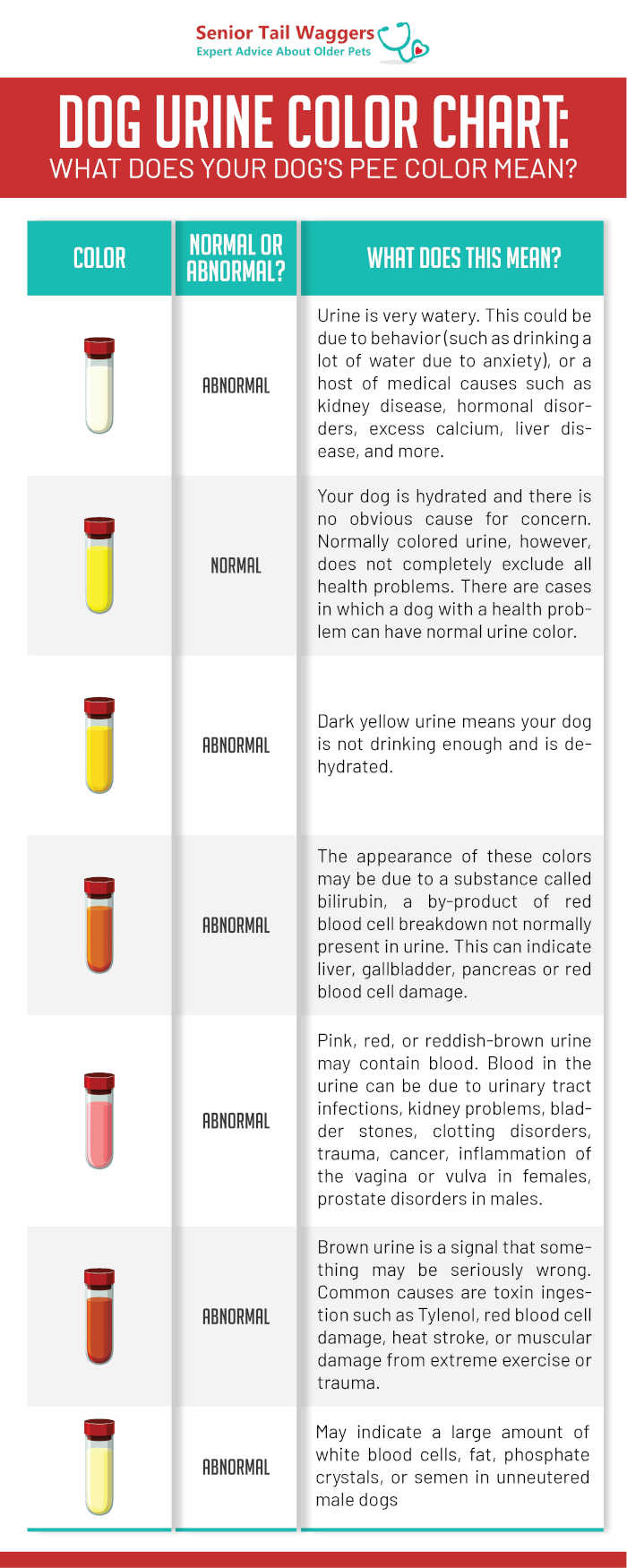
2. Dog urine color chart: what to do
| Color | Normal or Abnormal? | What To Do |
| Colorless or clear urine | Abnormal | Start monitoring your dog’s water intake and urine volume. Are they drinking a lot more water and urinating huge amounts at once? If so, schedule a vet appointment for your dog to determine what’s going on. |
| Light yellow to amber | Normal | You’re doing great! If your dog is acting normally with no symptoms, no further action is necessary. |
| Dark yellow | Abnormal | Increase your dog’s water intake. Make sure fresh water is always available. If your dog has been vomiting or having diarrhea, talk to a vet about helping to replenish fluids. |
| Very dark yellow-brown, orange, or green | Abnormal | Schedule a vet appointment. The vet will likely recommend blood tests and a urine analysis test. If your dog has other symptoms such as change in appetite, lethargy, behavior changes, or pain, then an urgent vet visit is recommended. |
| Pink, red, or reddish-brown | Abnormal | Schedule a vet appointment. The vet may recommend blood tests, urine testing, a urine culture test, and a bladder x-ray or ultrasound. |
| Brown | Abnormal | Have your dog evaluated by a vet immediately. Your dog may be in shock with increased heart rate, pale white or blue tinged gums, lethargy, and difficulty breathing. |
| Milky white | Abnormal | Schedule a vet appointment. |
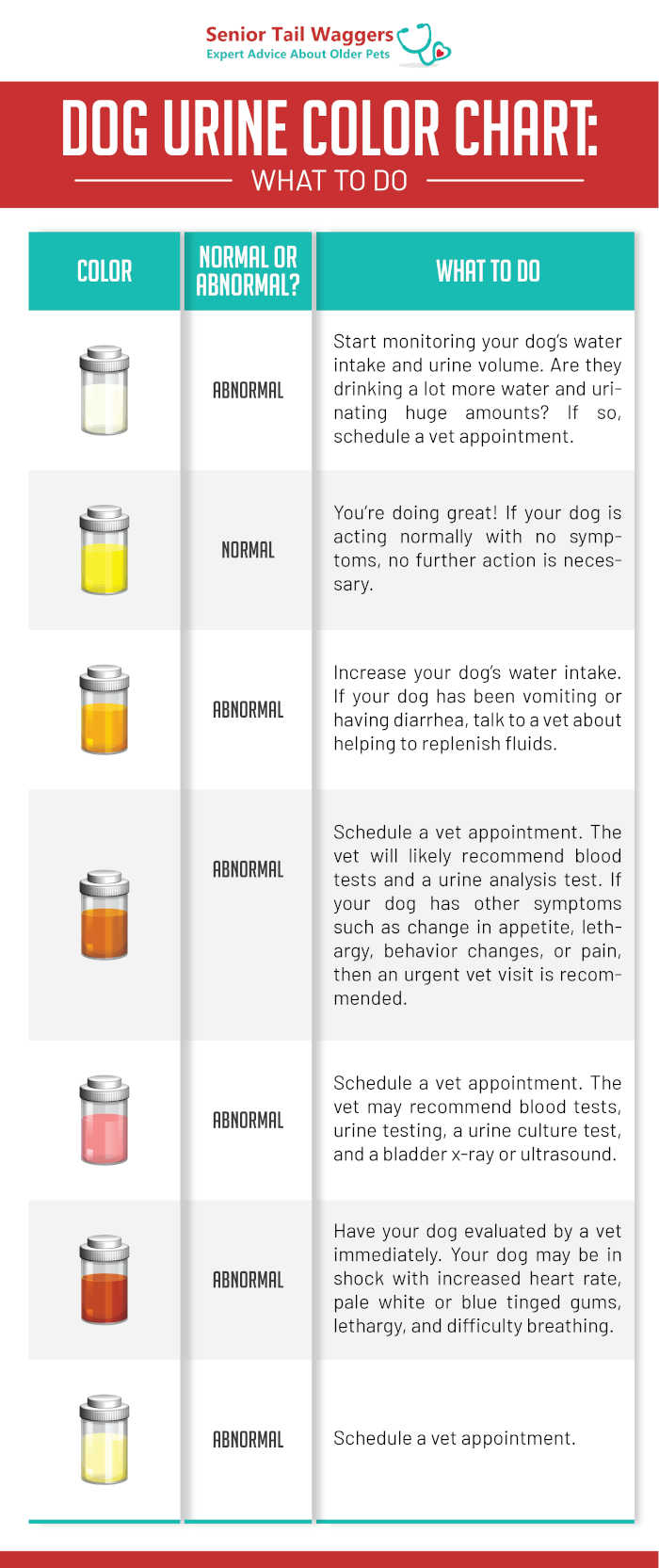
How to collect and check a dog’s urine color
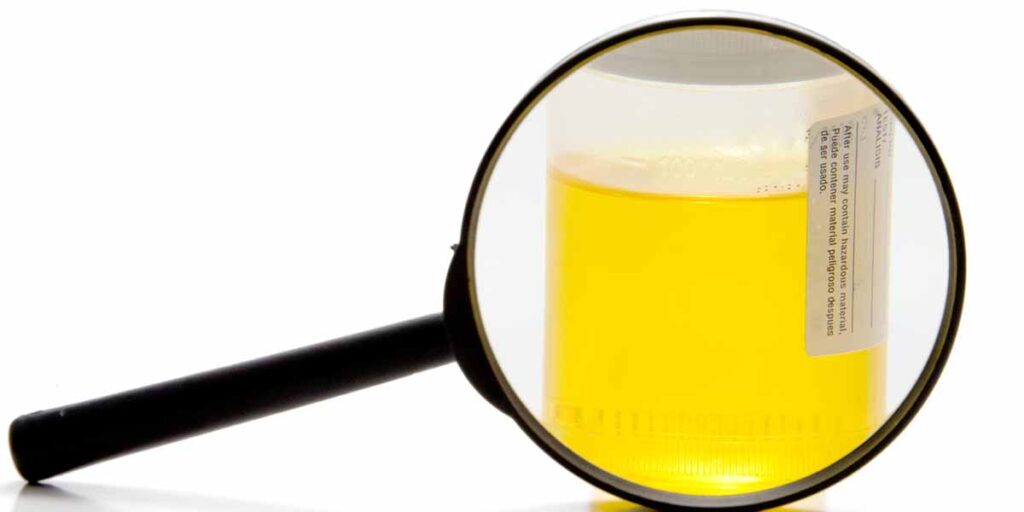
You may suspect that your dog’s urine color is abnormal from an accident at home on the carpet, or if they happen to urinate outside on a non-absorbent surface like cement. Be aware that the color of the ground may make the urine color appear different from its actual color. To double check the color, it is best to get a sample of urine. The best way to collect your dog’s urine sample at home is via the “free catch” collection method. If you are unable to collect any sample at all, a less ideal alternative is to slide a potty pad under your dog during urination. You can get an idea of the urine color against the white pad and ask your dog’s vet to collect a sample and verify if needed.
Steps for obtaining a free-catch sample:
1. Prepare a clean container. For female dogs and their lower urination posture, it may be easier to use a shallow container with a larger surface area such as a lid or a disposable plate with a rim. There are consumer products meant for helping to catch urine, such as the Paw Check P-Scoop, which has a longer handle for ease of collection.
2. Wear gloves. It is best to prevent any diseases, however uncommon, that can be transmitted from dogs to humans through urine.
3. Once your dog starts to urinate, wait a few seconds and then slide the container into the urine stream. You want to collect a few teaspoons worth.
4. Immediately after collection, pour the urine off into a clean, clear or white-colored container or cup to check the color. The color of the urine may change once it’s been at room temperature for a prolonged period of time.
5. I also recommend saving the sample in a closed container in the refrigerator in case that a vet visit is warranted. That way, the vet will have a backup sample to evaluate in case they are unable to obtain more urine during the appointment.
Note:
- The best time to catch the urine is in the middle of your dog’s urine stream, not the very beginning or the end. The reason for this is that a free-catch sample can often contain bacteria and skin cells from around the genital area and skin, and a mid-stream sample will decrease the chances of contamination.
FAQS
Can I tell if my dog has a UTI based on the color of the urine?
The short answer is not necessarily. If a dog has dark-colored, pink- to red-tinged, very cloudy, and pungent-smelling urine, especially in conjunction with what are called “lower urinary tract signs” such as frequent urination, accidents in the house, and straining to urinate, it is very possible that she could have a urinary tract infection. However, it is necessary for your dog to have a urine culture test, or at the very least a urinalysis test, before a UTI can be confirmed. There are other causes of blood in the urine such as bladder stones, cancer, and prostate disease (only in male dogs urinating blood). If your dog is exhibiting these signs or the urine appears similar to that description, it is best to make an appointment with the vet.
What kind of foods can change my dog’s urine color?
The majority of foods and drugs do not have an effect on urine color because they are lost during the digestive process.
Do I need to take my dog to the vet if the urine looks abnormal?
Consult the dog urine color chart above. Rarely, a change in the urine color can be due to diet, treats, or other environmental factors. If your dog’s urine appears pink or red, it is best to take your dog in to see the vet. If your dog’s urine is brown, a vet visit is recommended urgently. If your dog’s urine color has changed or the urine appears cloudy, and there are additional urinary symptoms like straining to urinate, having accidents in the house, or frequent urination, a vet visit is also recommended.
What tests will my vet recommend?
Common tests to evaluate a dog’s urine include a urinalysis and a urine culture. A urinalysis is a general urine test that evaluates how well the kidney is functioning and determines the health of the urinary tract. It does so by checking for bleeding, infection, inflammation, and formation of crystals, which can be precursors to bladder stones and sometimes cancer cells. Bloodwork is often recommended at the same time to get a complete picture of the internal state of the body.
How will the vet collect my dog’s urine?
There are multiple ways that urine can be collected at the vet’s office.
- The free-catch method was described above. This is the least invasive way to obtain a sample. However, it may not be as useful in certain situations due to possible contamination leading to inaccurate results.
- The most sterile, or clean, method of urine collection is cystocentesis, whereby a sterile needle is used to remove a sample of urine from the dog’s bladder. This is ideal for situations such as suspected urinary tract infections. However, it can sometimes introduce a small number of red blood cells into the urine due to the needle.
Related posts about dog peeing issues:
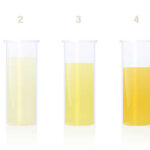 My Dog’s Pee is Clear: Should I Be Worried? [Vet Advice] - You might know that a dog's poop color can change based on their diet, but it's also true that their… [...]
My Dog’s Pee is Clear: Should I Be Worried? [Vet Advice] - You might know that a dog's poop color can change based on their diet, but it's also true that their… [...]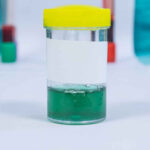 Green Dog Urine: What Does it Mean & What Should I do? - Why Your Dog’s Urine May Be Green Dog urine is a product of the kidneys filtering the dog’s blood to… [...]
Green Dog Urine: What Does it Mean & What Should I do? - Why Your Dog’s Urine May Be Green Dog urine is a product of the kidneys filtering the dog’s blood to… [...] Is This Blood in My Dog’s Pee? How Can I Tell? - Blood can take many forms in a dog’s urine and it can sometimes be hard to tell that there’s blood… [...]
Is This Blood in My Dog’s Pee? How Can I Tell? - Blood can take many forms in a dog’s urine and it can sometimes be hard to tell that there’s blood… [...] Suddenly, My Dog Is Peeing A Lot! What do I do? - As a practicing small animal veterinarian for 16 years, I have had the privilege of knowing many of my dog… [...]
Suddenly, My Dog Is Peeing A Lot! What do I do? - As a practicing small animal veterinarian for 16 years, I have had the privilege of knowing many of my dog… [...]Disclaimer: This website's content is not a substitute for veterinary care. Always consult with your veterinarian for healthcare decisions. Read More.



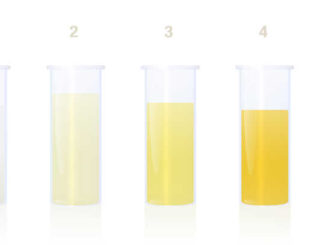
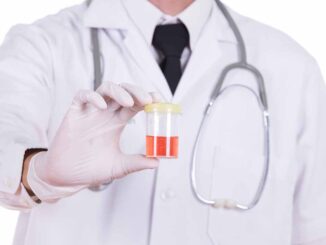
Be the first to comment